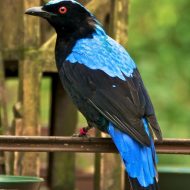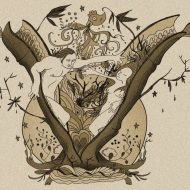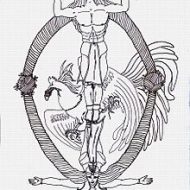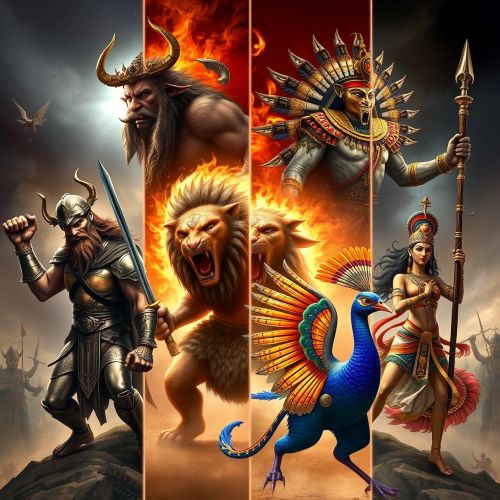Tigmamanukan : The Omen Bird
Listen
At a glance
| Description | |
|---|---|
| Origin | Philippine Mythology |
| Classification | Animals |
| Family Members | N/A |
| Region | Philippines |
| Associated With | Omens, Prophesy |
Tigmamanukan
Introduction
According to Tagalog beliefs, the Tigmamanukan serves as a crucial indicator for the outcome of anticipated journeys. If the bird takes flight to the right, the journey is foreseen to be prosperous; however, a leftward flight implies the traveler’s permanent absence. Additionally, there’s a belief that this mythical bird played a vital role in human evolution by assisting in the opening of primordial bamboo.
In Tagalog tradition, the Tigmamanukan was regarded as a significant symbol reflecting the success or failure of a journey. While various animals and birds were considered omens, the Tigmamanukan garnered special attention due to its distinctive behaviors. In the pre-colonial era, it was believed that Bathala dispatched this bird to forewarn individuals about their destinies. Moreover, the Tigmamanukan was believed to have aided in the pivotal act of opening the bamboo, considered the origin of humanity.
Physical Traits
The native Filipinos continued to hold onto their superstitious belief in the “Tigmamanukan” even after the introduction of the Roman Catholic religion to the Philippines during the Spanish colonial era. At the time, this term had come to be used exclusively to describe a mystifying small, dark-coloured bird that sought refuge in forests and farmlands throughout the archipelago. Despite the fact that the term “tigmamanukan” is no longer in common usage, some early western explorers claim that the particular bird meant by the name is a fairy bluebird.
Other names
The term “tigmamanukan” finds its roots in the Proto-Austronesian word “manuk,” exclusively denoting chickens in the Philippines. In pre-Christianization times, this term extended beyond its later association with chickens and referred to any animal or creature encountered along one’s path, serving as an indicator of success or failure. The term “encounter” likely stems from the practice of augury, wherein a chicken was sacrificed, and its entrails were examined to foresee the outcome of an event. This ancient ritual was conducted by shamans and priestesses during that era.
Powers and Abilities
The Tagalog people held the belief that the direction in which a tigmamanukan crossed an individual’s path served as a significant indicator of the anticipated outcome of a journey. This sign was also referred to as “labay,” translating to “proceed.” If the tigmamanukan flew to the left, it was believed that the travelers would not return. There were also accounts of hunters releasing the bird, having first removed its beak if captured.
The Tigmamanukan played a crucial role in the opening of the bamboo from which the first man, Malakas, and the first woman, Maganda, emerged. While some sources attribute this act to Amihan, the god of peace and wind in bird form, others claim that Bathala specifically named the Tigmamanukan involved as Manaul. According to certain accounts, Amihan’s bird form is identified as Manaul.
Modern Day Influence
While the term “tigmamanukan” has fallen out of contemporary usage, early Western explorers claim that the bird associated with it might be the fairy bluebird (genus Irena and family Irenidae). Specifically, Irena cyanogastra, known as the Philippine fairy bluebird, was identified by one explorer, while another labeled it as the Asian fairy bluebird (Irena puella turcosa). Regardless, the prevailing consensus among sources describing the tigmamanukan is its distinctive “blue” coloration.
A 2017 study, endorsed by the IUCN, highlighted that the Philippines is home to two Irena species: the Philippine fairy-bluebird (Irena cyanogastra), native to the faunal regions of Luzon and Mindanao, and the Palawan fairy-bluebird (Irena tweeddalii), acknowledged as a separate species from the Asian fairy-bluebird (Irena puella) in the same year.
Related Images
Frequently Asked Questions
What is lorem Ipsum?
I am text block. Click edit button to change this text. Lorem ipsum dolor sit amet, consectetur adipiscing elit. Ut elit tellus, luctus nec ullamcorper mattis, pulvinar dapibus leo.
What is lorem Ipsum?
I am text block. Click edit button to change this text. Lorem ipsum dolor sit amet, consectetur adipiscing elit. Ut elit tellus, luctus nec ullamcorper mattis, pulvinar dapibus leo.
What is lorem Ipsum?
I am text block. Click edit button to change this text. Lorem ipsum dolor sit amet, consectetur adipiscing elit. Ut elit tellus, luctus nec ullamcorper mattis, pulvinar dapibus leo.
What is lorem Ipsum?
I am text block. Click edit button to change this text. Lorem ipsum dolor sit amet, consectetur adipiscing elit. Ut elit tellus, luctus nec ullamcorper mattis, pulvinar dapibus leo.
What is lorem Ipsum?
I am text block. Click edit button to change this text. Lorem ipsum dolor sit amet, consectetur adipiscing elit. Ut elit tellus, luctus nec ullamcorper mattis, pulvinar dapibus leo.









